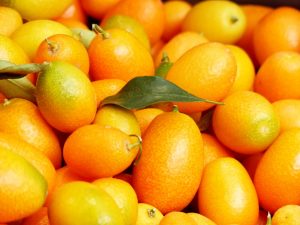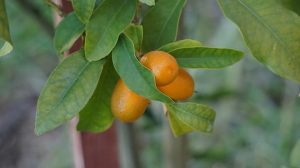What is Kumquat?

Always wanted to try a kumquat but not sure how to eat it? Our Kumquat guide will tell you everything you need to know about the citrus fruit.
kumquats are part of the citrus family and are the smallest of this variety. They are native from China but also found in North and South Korea, the the Middle East, U.S, Japan and other countries.
Kumquat is no ordinary citrus fruit, it sets itself apart from the others. Its skin can be consumed unlike other fruits in its family as it has a sweet taste to it.
Below are some facts from the Kumquat guide you’ll find useful about the fruit.
kumquat varieties
kumquats come in 3 different varieties these are:
Nagami Kumquat: This type of kumquat is football shape and can commonly be purchased in markets
Meiwa Kumquat: These kumquats are the tastes and come in a round shape
Fukushu Kumquat: The larger variety of kumquat and tends to be sweeter than the other kumquat varieties. This Kumquat also has thicker skin than the other 2 types.
What do Kumquat’s look like?
Kumquats are the shape of an oval orange. They come in different sizes, but they are still the smallest of the citrus family.
What does a Kumquat taste like?
The main difference between a kumquat and other citrus fruits like orange is the sugar content. Kumquats are like oranges reversed the skin is sweet and the inside is sour. Apart from the fact, the skin of an orange is not edible.
Kumquats can be eaten raw, once you start to eat this fruit the sour taste will hit you as soon as it enters your mouth. As you continue to chew through the skin you’ll start to taste the sweetness.
Kumquat benefits

Fights against Gram-Positive, Gram-negative bacteria, and Fungus
Kumquat fights against bacteria and fungus. One of its properties is producing great antimicrobial activity against bacteria and fungus.
The Meiwa Kumquat thrives in essential oils. This has been well known to fight against Gram-Positive, Gram-negative bacteria, and Fungus.
The Essential oils from the Kumquat as also been well own to act as a food preservative. Is known to increase the shelf life of food.
Provided natural colour and flavor to Icecream
There have been many studies where Paste made from the Kumquat fruit were added to icecream. The paste was added at different concentrates. The studies showed that by adding the paste it enhanced many properties of the ice cream such as the colour, flavour, Vitamin C, Mg, and K contents with in the ice cream.
Source of bioactive Polyphenols
Antioxidants found in plant-based components are called polyphenols. There have been studies that find kumquats are rich in polyphenols making them high in antioxidants.
Loaded with Vitamin C
Kumquats are loaded with vitamin C. Like many of the citrus family they can be a great way to getting your daily dosage of vitamin C.
Kumquats are also rich in Carotenoids
Vegetables and fruits get their vibrant colours from plant-based pigments, these are called Carotenoids.
These Carotenoids from plants can act as antioxidants and prevent health issues such as photoinduced tissue damage, enhancing immune response and, inhibition of mutagens.
Kumquat Tree Facts

- Kumquat trees can withstand extreme weather ranging from -8degrees celsius to 18 degrees celsius.
It’s easy to grow Kumquat trees as they can tolerate seaside conditions.
The Kumquat tree can look as beautiful as a bonsai tree once it starts to grow fruits. - This type of tree can grow both inside and outside.
Jasmin flowers grow on the Kumquat tree making them smell sweet.
Growing Kumquat trees - Its recommended buying a Kumquat tree. Growing a Kumquat tree from the seeds can take longer and the fruit baring process may take more time.
- If you’d like to grow a Kumquat tree from seeds the germination process would be the same as any citrus tree.
- The Kumquat tree should only be watered when completely dry. You can pat the soil with your hand to see how dry the tree is and water according to its needs.
- Try not to prune your Kumquat tree as it can slow down the fruit-bearing process.
- When growing your Kumquat tree indoors you may want to grow it in a plant pot. Try to add some gravel or stones to the pot to help drain the water.
How to eat Kumquat

The Kumquat fruit can be eaten cooked or raw as is. It’s great to just pick the fruit off the tree and it the way it is. You can make the fruit into other delicious condiments such as Marmalade’s and chutney’s.
As mentioned earlier it’s safe to eat the skin of a Kumquat. The skin is where all the sweetness lies and the center is where the sourness lies.
When your eating your Kumquat always remember they have seeds just like an orange. Don’t forget to throw them out, unless your planning on germinating them.
After reading the Kumquat Guide check out the benefits of Chaga Mushrooms.
Enjoyed our blog on the Kumquat guide why not try them for yourself or even grow your own tree!